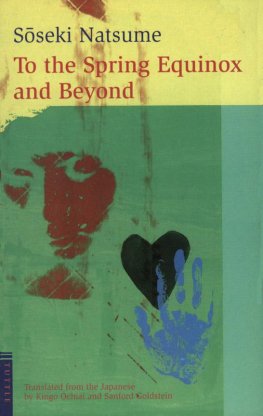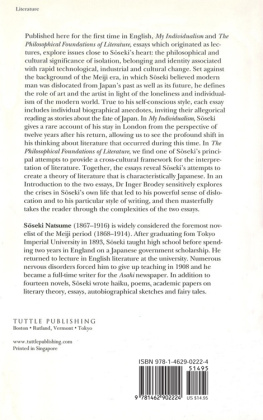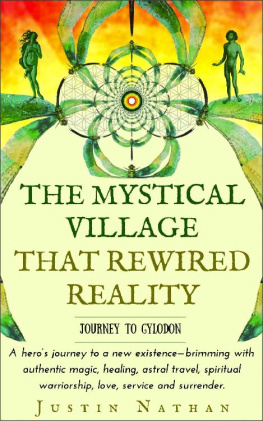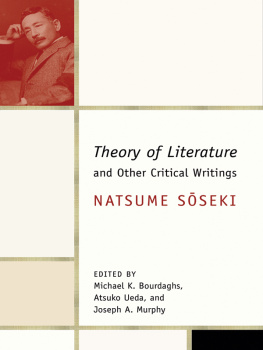John Nathan - Sōseki
Here you can read online John Nathan - Sōseki full text of the book (entire story) in english for free. Download pdf and epub, get meaning, cover and reviews about this ebook. publisher: Columbia University Press, genre: Detective and thriller. Description of the work, (preface) as well as reviews are available. Best literature library LitArk.com created for fans of good reading and offers a wide selection of genres:
Romance novel
Science fiction
Adventure
Detective
Science
History
Home and family
Prose
Art
Politics
Computer
Non-fiction
Religion
Business
Children
Humor
Choose a favorite category and find really read worthwhile books. Enjoy immersion in the world of imagination, feel the emotions of the characters or learn something new for yourself, make an fascinating discovery.

- Book:Sōseki
- Author:
- Publisher:Columbia University Press
- Genre:
- Rating:4 / 5
- Favourites:Add to favourites
- Your mark:
- 80
- 1
- 2
- 3
- 4
- 5
Sōseki: summary, description and annotation
We offer to read an annotation, description, summary or preface (depends on what the author of the book "Sōseki" wrote himself). If you haven't found the necessary information about the book — write in the comments, we will try to find it.
Sōseki — read online for free the complete book (whole text) full work
Below is the text of the book, divided by pages. System saving the place of the last page read, allows you to conveniently read the book "Sōseki" online for free, without having to search again every time where you left off. Put a bookmark, and you can go to the page where you finished reading at any time.
Font size:
Interval:
Bookmark:
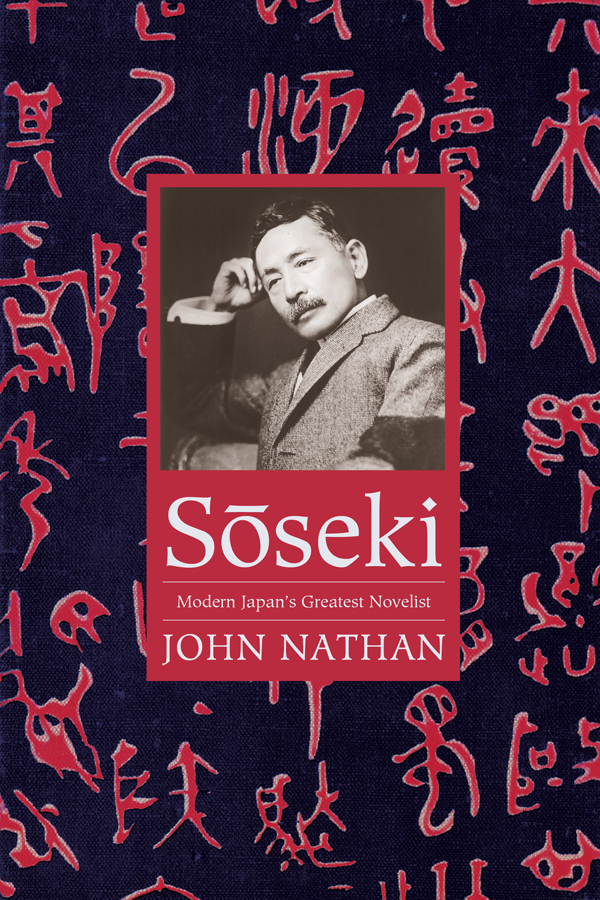
Sseki
ASIA PERSPECTIVES
WEATHERHEAD EAST ASIAN INSTITUTE, COLUMBIA UNIVERSITY
ASIA PERSPECTIVES: HISTORY, SOCIETY, AND CULTURE
A series of the Weatherhead East Asian Institute, Columbia University
For a list of titles in this series, see .
OTHER WORKS BY JOHN NATHAN
Living Carelessly in Tokyo and Elsewhere (memoir)
Sony: The Private Life
Japan Unbound
Mishima: A Biography
TRANSLATIONS
Light and Dark (Natsume Sseki)
Rouse Up, O Young Men of the New Age! (e Kenzabur)
Teach Us to Outgrow Our Madness (e Kenzabur)
A Personal Matter (e Kenzabur)
The Sailor Who Fell from Grace with the Sea (Mishima Yukio)
FICTION
Dragon Gate
A Bintel Brief
Sseki

Modern Japans Greatest Novelist
John Nathan

COLUMBIA UNIVERSITY PRESS
New York
Columbia University Press
Publishers Since 1893
New York Chichester, West Sussex
cup.columbia.edu
Copyright 2018 John Nathan
All rights reserved
E-ISBN 978-0-231-54697-3
Library of Congress Cataloging-in-Publication Data
Names: Nathan, John, 1940 author.
Title: Soseki : modern Japans greatest novelist / John Nathan.
Description: New York : Columbia University Press, 2018. | Series: Asia perspectives: history, society, and culture | Includes bibliographical references and index.
Identifiers: LCCN 2017037948 | ISBN 9780231171427 (cloth : alk. paper)
Subjects: LCSH: Natsume, Soseki, 18671916. | Novelists, Japanese20th centuryBiography.
Classification: LCC PL812.A8 Z82548 2018 | DDC 895.63/42dc23
LC record available at https://lccn.loc.gov/2017037948
A Columbia University Press E-book.
CUP would be pleased to hear about your reading experience with this e-book at .
Cover design : Milenda Nan Ok Lee
Cover image : Designed by Natsume Sseki for the cover of his novel Kokoro (1914), the pattern is based on a rubbing of an ancient Chinese inscription on stone, done in the style of calligraphy known as seal script.
Cover inset photo : Natsume Sseki, on the occasion of Emperor Meijis funeral. Tokyo, September 13, 1912. (Photo by Ogawa Kazumasa; courtesy of the Museum of Modern Japanese Literature)

For baby grandson Noah,
And in memory of our Jeremiah
Contents
In the panorama of modern Japanese literature, Natsume Sseki (18671916) stands alone, an unflaggingly original pioneer. He was thirty-eight, a scholar of English literature with serious doubts about himself, when he finally turned to writing fiction. Between 1905 and his death in 1916, he produced fourteen largely grim novels that revealed characters with a depth and exactitude that had no precedent in Japan. He is properly viewed as Japans first modern novelist, certainly in the Western sense of that notion.
The interest and significance of Ssekis life extend beyond his literary achievement. He was born on the cusp of a social revolution; his struggle to synthesize Japanese sensibilities and Western approaches to the novel mirrored the national effort to build a modern state by fusing traditional and Western elements. His life reveals lucidly and poignantly the pain and paralyzing cost of, as he put it, incurring a foreign culture.
Ssekis accomplishment appears the more remarkable considering that he had no predecessors. His contemporaries in EnglandGeorge Meredith, Thomas Hardy, Joseph Conrad, and Henry Jameswere inspired and nourished by a tradition that began in the early eighteenth century and extended beyond them to the modernism of Virginia Woolf and James Joyce. Ssekis realism, in contrast, appeared out of the blue: no survey of eighteenth- and nineteenth-century Japanese fiction, lampoons and parodies, morality tales, and melodramas populated by improbable characters prepares the reader for his ability to create individuals who are true to life.
Inasmuch as his complete oeuvre, including novellas and short stories, was written in the scant space of eleven yearsan astonishing feat enabled by his vast talent and desperate energyit is hard to speak of early, middle, and late Sseki. In fact, his grasp of narrative strategy, including multiple points of view and irony, possibly acquired from his reading of Lawrence Sterne and Jane Austen, among others, is already strikingly evident in his first novel, I Am a Cat (1905), and in his shorter comic masterpiece, Botchan (1905). Not that he does not evolve: rapid as it was, the attentive reader can track his stylistic progress from one novel to the next as he increasingly bent the Japanese language to his will, transforming it into the precision instrument he needed while preserving its genius for the indefinite.
Sseki achieved critical acclaim and immense popularity during his lifetime. Today, one hundred years after his death, he abides in the Japanese imagination with a luminosity that recalls the Jane Austen phenomenon in England and America. There is abundant evidence of his lionization: from 1984 through 2004, his portrait was engraved on the face of the 1,000-yen note (roughly equivalent to a ten-dollar bill); generations of high school students have been expected to memorize passages from his novels; he is cited as a source in large dictionaries more often than any other modern Japanese writer; and to this day, he is voted the most representative Japanese author in national polls, ahead of Murasaki Shikibu, the author of The Tale of Genji .
Between April and September 2014, the Asahi shinbun commemorated the centennial of its first appearance in that newspaper with a serial republication of Kokoro , Ssekis most popular novel, in the original 1914 format. Readers responded with such enthusiasmas of August 2014, sales of Kokoro in just one paperback edition had surged to seven million copiesthat the Asahi followed with Sanshir (1908), And Then (1909), and The Gate (1910) and is currently midway through the perennial best seller, I Am a Cat (1905). On December 9, 2016, the hundredth anniversary of his death, a Sseki android was unveiled. Dressed in an English suit and choker collar and wearing kid shoes, with its features modeled on the death mask owned by the Asahi shinbun , the seated four-foot figure (the size of a puppet-theater doll) recites selections from Ssekis Ten Nights of Dreams in his grandsons voice, said to resemble his own. On display at university gatherings, the android draws crowds.
Considering the darkness that pervades his work, it is not easy to account for Ssekis enduring appeal. Perhaps he continues to awaken in Japanese readers recognition, if not familiarity, with his representation of life as a travail in which integrity and pride are hard to sustain and happiness lies mainly beyond reach.
Since the 1980s, Japanese scholars have produced dozens of books and hundreds of articles about Sseki every year. A number of Western scholars have also contributed to this corpus of criticism. In the main, the new work is linguistic, structuralist, and narratological, examining Ssekis fiction in the light of gender studies, feminism, queer theory, and a heightened sensitivity to imperialism that detects its implicit presence in the darkest corners. Overall, the purpose of the endeavor has been to liberate Sseki from the limitations of an exceptionalist characterization as a Japanese novelist and to install him alongside other great writers of global literature where he belongs.
Font size:
Interval:
Bookmark:
Similar books «Sōseki»
Look at similar books to Sōseki. We have selected literature similar in name and meaning in the hope of providing readers with more options to find new, interesting, not yet read works.
Discussion, reviews of the book Sōseki and just readers' own opinions. Leave your comments, write what you think about the work, its meaning or the main characters. Specify what exactly you liked and what you didn't like, and why you think so.

